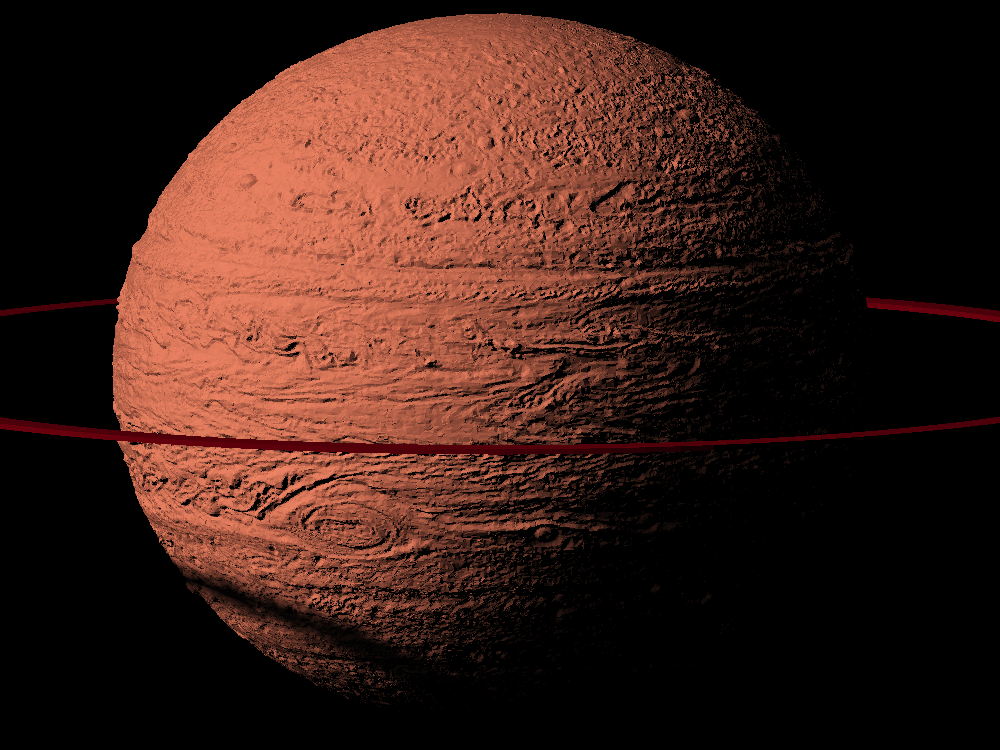
Jupiter scaled one in one billion
prusaprinters
<p>Originally published here: <a href="https://www.thingiverse.com/thing:3928031">Jupiter scaled one in one billion by tato_713 - Thingiverse</a></p><p>As well as my other post on gas giants, this is not a true relief of the surface of Jupiter, because it has not a solid surface, but it is instead a interpretation of the height of the clouds as proportional to the albedo (brightness). Contrary to my posts of <a href="https://www.prusaprinters.org/prints/57336-uranus-scaled-one-in-250-million">Uranus</a> and <a href="https://www.prusaprinters.org/prints/57330-neptune-scaled-one-in-250-million">Neptune</a>, in which I've used high contrasted images and mosaics of the planets, with Jupiter I used a global map in true color, that I high-passed to keep only the "turbulence" of the atmosphere, discarding the bright level of some bands. As well with the other gas planets, the clouds moves and the bands of atmosphere rotate at different spins, so the map is valid for the moment the photos were taken. It was modelled using MATLAB R2016a. The model is scaled one in one billion, or one in one thousand million in the long scale system. In this scale, the Earth is about 1cm in diameter. The ring system of Jupiter is far reduced when compared with that of <a href="https://www.prusaprinters.org/prints/57355-saturn-scaled-one-in-500-million">Saturn</a>, even with the one of the ice giants. Here it is simplified to the main ring only.</p><p>The file's names explained: <i>name_1_x_10_y.stl</i> is 1 : x* 10^y. So _1_6_10_7 is 1:600000000 or one in 60 million.</p><h3>Jupiter</h3><p>Jupiter is the biggest and most massive planet in the Solar System. It is so massive that the barycenter between the Sun and Jupiter lays outside the star. It is also the faster in rotational period, taking less than 10 hours to do a jovian day. Jupiter is known for being a sort of "vacuum cleaner" of the Solar System, scattering small asteroids from their orbits into a high unstable one. This is true also for comets. Small interactions in the high eccentrical orbit of a comet could make their orbital parameters change drastically, slowing down to a smaller Jupiter-resonant orbit, or accelerating them to the point they escape of the Solar System. This is thought to be an important factor in the search of life conditions among <a href="https://www.prusaprinters.org/prints/57340-exoplanets-scaled-one-in-120-million">exoplanets</a>. A big Jupiter sized planet could help to clean the system of potentially hazardous asteroids for an <a href="https://www.prusaprinters.org/prints/57301-earth-with-exaggerated-topography-scaled-one-in-si">Earth</a> like planet of that system. The most noticeable feature of the jovian surface is the Great Red Spot, a storm of the size of the Earth on the southern hemisphere. It has four big satellites, the Galileans Moons: <a href="https://www.prusaprinters.org/prints/57270-io-with-known-topography-scaled-one-in-twenty-mill">Io</a>, <a href="https://www.prusaprinters.org/prints/57273-europa-with-approximate-topography-scaled-one-in-t">Europa</a>, <a href="https://www.prusaprinters.org/prints/57303-ganymede-with-exaggerated-topography-scaled-one-in">Ganymede</a> and <a href="https://www.prusaprinters.org/prints/57305-callisto-with-known-topography-scaled-one-in-sixty">Callisto</a>. The biggest one, Ganymede, is bigger, but lighter, than the planet <a href="https://www.prusaprinters.org/prints/57282-mercury-with-exaggerated-topography-scaled-one-in-">Mercury</a>. The rest of the moons are far smaller (like <a href="https://www.prusaprinters.org/prints/57269-amalthea-scaled-one-in-four-million">Amalthea</a>, <a href="https://www.prusaprinters.org/prints/57307-thebe-scaled-one-in-two-million">Thebe</a> and Himalia), and they have not the enough mass to be rounded.</p><ul><li><strong>Type:</strong> Planet. Gas giant. </li><li><strong>Orbit:</strong> Sun. </li><li><strong>Orbital period:</strong> 11.862 yr. </li><li><strong>Rotational period:</strong> 9 h 55 min 30 s. </li><li><strong>Composition:</strong> Hydrogen, helium atmosphere; metallic hydrogen mantle, rocky core. </li><li><strong>Density:</strong> 1.326 g/cm3. </li><li><strong>Dimensions:</strong> 142984 km × 133708 km </li><li><strong>Model scale:</strong> 1:5x108 (28cm) 1:1x109 (14cm)</li></ul><h4>References</h4><ul><li><a href="https://www.jpl.nasa.gov/spaceimages/details.php?id=PIA07782">Map of Jupiter</a></li><li><a href="https://www.mathworks.com/matlabcentral/fileexchange/4512-surf2stl">Surf to STL function for MATLAB</a></li></ul><h3><strong>Other astronomical objects</strong></h3><p><a href="https://www.prusaprinters.org/social/120859-tato_713/collections/49826">Inner Solar System</a></p><p><a href="https://www.prusaprinters.org/social/120859-tato_713/collections/49832">Artificial</a></p><p><a href="https://www.prusaprinters.org/social/120859-tato_713/collections/49820">Near Earth Asteroids</a></p><p><a href="https://www.prusaprinters.org/social/120859-tato_713/collections/49291">Main Belt Asteroids</a></p><p><a href="https://www.prusaprinters.org/social/120859-tato_713/collections/49829">Jovian System</a></p><p><a href="https://www.prusaprinters.org/social/120859-tato_713/collections/49828">Saturn System</a></p><p><a href="https://www.prusaprinters.org/social/120859-tato_713/collections/49830">Uranian System</a></p><p><a href="https://www.prusaprinters.org/social/120859-tato_713/collections/49345">Neptunian System</a></p><p><a href="https://www.prusaprinters.org/social/120859-tato_713/collections/49827">Centaurs</a></p><p><a href="https://www.prusaprinters.org/social/120859-tato_713/collections/49833">Comets</a></p><p><a href="https://www.prusaprinters.org/social/120859-tato_713/collections/49341">Trans Neptunian Objects</a></p><p><a href="https://www.prusaprinters.org/social/120859-tato_713/collections/49824">Extrasolar Objects</a></p><p><a href="https://www.prusaprinters.org/social/120859-tato_713/collections/49837">Sky Maps</a></p><p><a href="https://www.prusaprinters.org/social/120859-tato_713/collections/49831">Ancient</a></p><p><a href="https://www.prusaprinters.org/social/120859-tato_713/collections/49822">Speculative</a></p><p><a href="https://www.prusaprinters.org/social/120859-tato_713/collections/49821">Science Fiction</a></p>
With this file you will be able to print Jupiter scaled one in one billion with your 3D printer. Click on the button and save the file on your computer to work, edit or customize your design. You can also find more 3D designs for printers on Jupiter scaled one in one billion.
